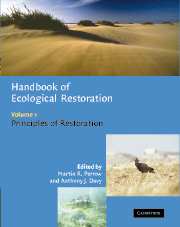Book contents
- Frontmatter
- Contents
- List of contributors
- Foreword
- Preface
- Part 1 The background
- Part 2 Manipulation of the physical environment
- Part 3 Manipulation of the chemical environment
- Part 4 Manipulation of the biota
- 12 Establishment and manipulation of plant populations and communities in terrestrial systems
- 13 Ecology and management of plants in aquatic ecosystems
- 14 Micro-organisms
- 15 Terrestrial invertebrates
- 16 Aquatic invertebrates
- 17 Fish
- 18 Reptiles and amphibians
- 19 Birds
- 20 Mammals
- Part 5 Monitoring and appraisal
- Index
- References
19 - Birds
Published online by Cambridge University Press: 29 December 2009
- Frontmatter
- Contents
- List of contributors
- Foreword
- Preface
- Part 1 The background
- Part 2 Manipulation of the physical environment
- Part 3 Manipulation of the chemical environment
- Part 4 Manipulation of the biota
- 12 Establishment and manipulation of plant populations and communities in terrestrial systems
- 13 Ecology and management of plants in aquatic ecosystems
- 14 Micro-organisms
- 15 Terrestrial invertebrates
- 16 Aquatic invertebrates
- 17 Fish
- 18 Reptiles and amphibians
- 19 Birds
- 20 Mammals
- Part 5 Monitoring and appraisal
- Index
- References
Summary
INTRODUCTION
Birds form one of the most diversified groups of terrestrial vertebrates. With approximately 10, 000 species and 300 billion individuals, birds are distributed world-wide, and occur on every continent (Gill, 1994). Because of their extraordinary array of adaptations in form and function – a product of at least 150 million years of evolution – birds inhabit an extraordinary array of different habitats, ranging from grasslands to tropical forests, from small ponds to the largest oceans, from searing deserts to the frigid climates found in the Arctic and Antarctic (Gill, 1994).
Because many species are sensitive to human-induced changes to the land, birds can be used as a valuable metric to determine the degree of habitat degradation, or conversely, the level of habitat restoration. For example, if one wants to assess the biodiversity status of a region, the number of threatened birds is generally regarded as a suitable indicator. Also, if one wants to follow the pace of vegetation recovery following any kind of man-made disturbance, bird diversity and composition are key variables to be monitored (Furness & Greenwood, 1993).
This chapter has three main parts. The first focuses on the restoration of bird populations, with special emphasis on endangered species. We discuss the methods that have been made to increase the severely depleted populations of particular bird species, to a condition similar to those prior to human interference, or at least to a population level that provides a high probability of long-term viability.
- Type
- Chapter
- Information
- Handbook of Ecological Restoration , pp. 376 - 388Publisher: Cambridge University PressPrint publication year: 2002
References
- 3
- Cited by



